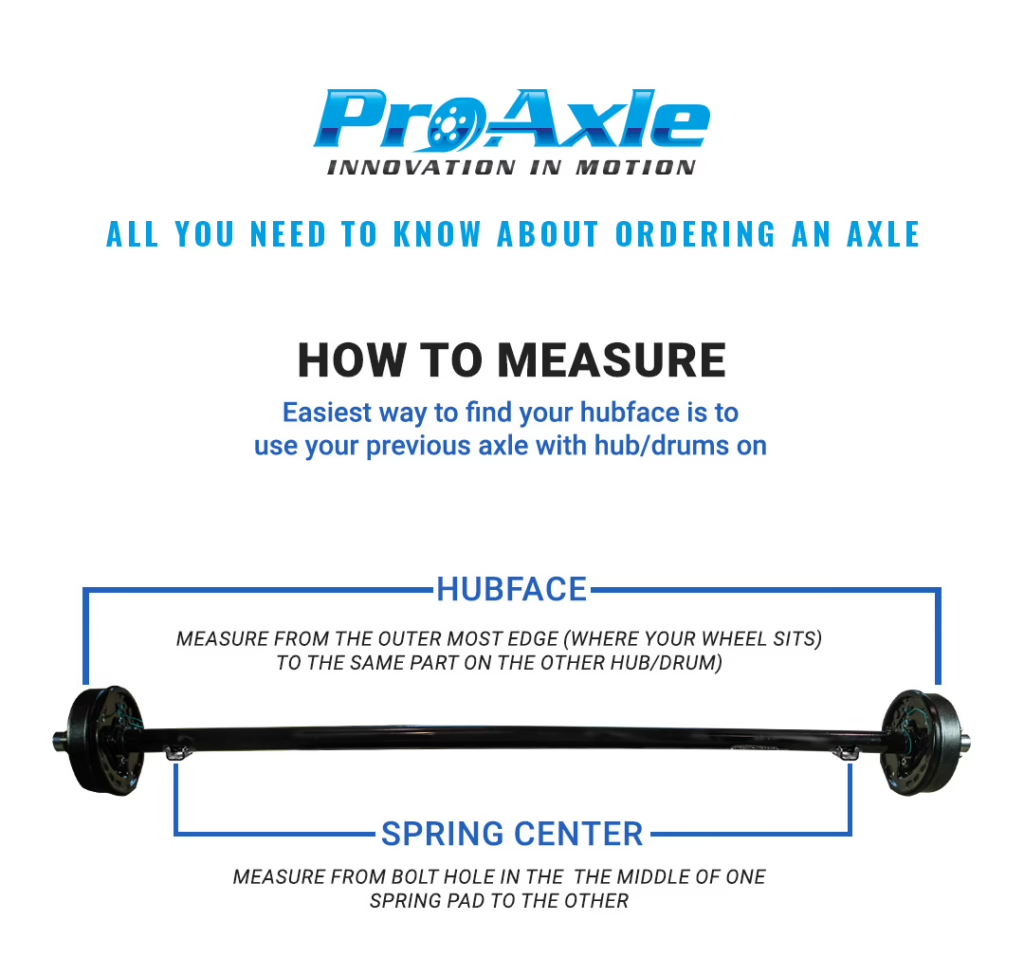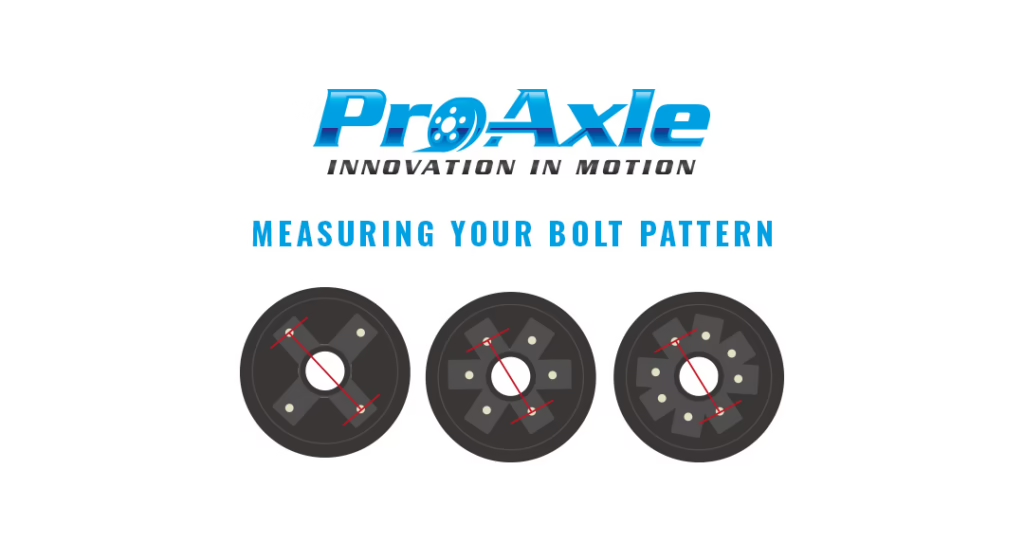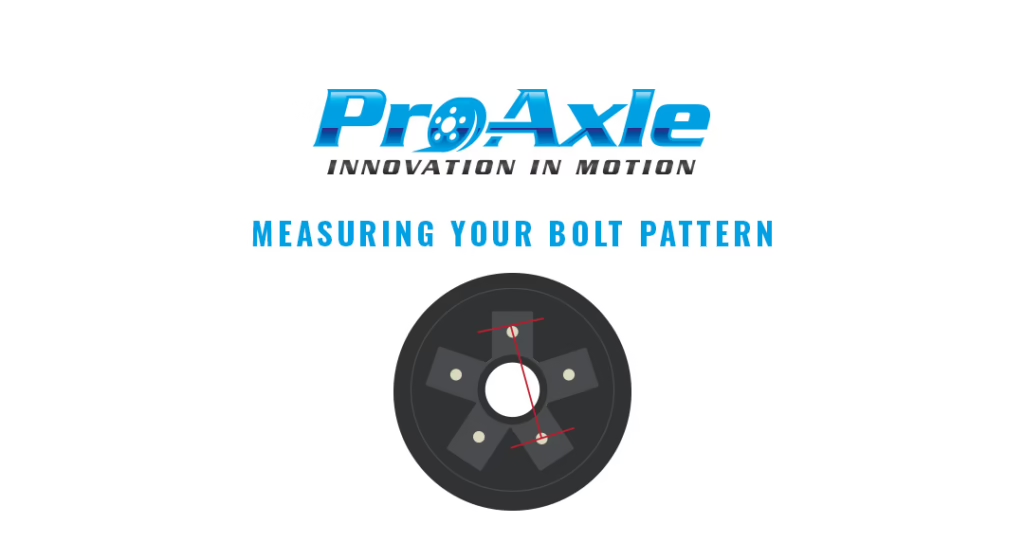Files that will help teach you or guide you in finding the measurements for your Trailer Axles.

Trailer Axle Measurement Guide – TowParts.com
When working with trailer axles, a few key measurements are essential to ensure proper fitment and performance. Accurate measurements are crucial to avoid unnecessary wear, damage, or safety issues. Below, we’ll explain how to measure your axle with confidence.
Getting Started
To make the process easier, it’s best to remove your tires and wheels before taking measurements. This allows for more precise readings. If removing them isn’t possible, you can measure from the center of one tire to the center of the opposite tire. Having a friend assist by holding one end of the tape measure is helpful but not absolutely necessary.
Hub Face Measurement
What is it?
The hub face measurement is the distance from the outer face of one hub (where the wheel mounts) to the outer face of the opposite hub. This is the most important measurement when replacing or upgrading an axle.
How to measure:
1.Hook your tape measure to the outer face of one hub (the side facing the wheel).
2.Extend the tape measure across the axle to the outer face of the hub on the opposite side.
3.Be careful not to measure to the inside face of the hub—measure only to the outer face for accuracy.
Spring Center Measurement
What is it?
The spring center measurement is the distance between the centers of the leaf springs. This measurement is critical for proper axle placement and load distribution. If the springs are installed incorrectly, it can lead to bent axles and unsafe towing conditions.
How to measure:
1.Have a friend hold one end of the tape measure at the exact center of one spring.
2.Stretch the tape measure to the exact center of the opposite spring.
3.If you’re working alone, hook the tape measure on the outside edge of one spring and measure to the inside edge of the opposite spring. Subtract the width of the spring to determine the center-to-center distance.
Tips for Accurate Measurements
•Always double-check your measurements before ordering or installing a new axle.
•If you’re unsure or need help, reach out to our experts at TowParts.com for guidance.
•Use a high-quality tape measure with clear markings to avoid errors.
Pro Tip: Keep these measurements handy when contacting TowParts.com for axle replacements or upgrades. Our team is happy to assist you with any questions or concerns!


Trailer Axle and Hub Selection Guide – TowParts.com
Proper axle positioning and hub selection are essential for building or repairing your trailer. Here’s a detailed guide to help you make the right choices with confidence.
How to Purchase the Correct Trailer Hub or Drum
Selecting the right hub or drum is a critical step in repairing your trailer axle. Follow these simple steps to ensure you get the correct fit:
Step 1: Remove the Hub or Drum
Carefully remove the hub or drum from your trailer axle. This will allow you to measure and inspect the components for identification.
Step 2: Measure the Bolt Pattern
Determine your axle’s capacity by measuring the bolt pattern. This step is crucial if the capacity is unknown. Use a bolt pattern diagram to identify the correct measurements.
Helpful Tip: A 5-lug bolt pattern can sometimes be tricky. Use our bolt pattern guide for accurate results.
Step 3: Identify the Bearings and Seal
1.Remove the front and rear bearings and the seal from the hub.
2.Look for numbers stamped on the bearings. These numbers correspond to the spindle size.
3.If the numbers are not readable, measure the inside dimensions of the bearings and seal using calipers.
4.Refer to our bearing measurement guide for step-by-step instructions.
Step 4: Select the Best Hub or Drum for Your Needs
Once you have the measurements and information, choose the hub or drum that fits your requirements.
Need Help?
If you’re unsure, the TowParts.com team is here to assist! We’ll guide you through selecting the correct hub or drum to ensure a perfect fit for your trailer.
Why Choose TowParts.com?
•Expert Assistance: Our knowledgeable team is ready to help with your trailer needs.
•High-Quality Products: We offer durable, reliable parts built to last.
•Comprehensive Resources: Explore our website for diagrams, measurement guides, and installation tips.
For more information, contact us at 1 (888) HAUL 360 or visit TowParts.com. Let us help you get back on the road safely and efficiently!
ProAxles 6K Trailer Axle Options – 6,000 lb Capacity
Available Configurations: Beam Axle, Idler Axle, and Brake Axle
Product Overview:
Upgrade your trailer with the ProAxles 6K Trailer Axle Options—a robust, high-performance axle system engineered to handle heavy-duty loads with ease. With a 6,000 lb capacity and precision 3” high-strength steel tube construction, these axle configurations are ideal for a wide range of applications, from utility trailers and car haulers to boat and cargo trailers. Choose the configuration that best suits your needs:
• Beam Axle: A straight axle beam designed for standard applications and customizable to accommodate your choice of hubs, brakes, and bearing kits (sold separately).
• Idler Axle: Engineered for non-braking applications, the idler axle offers the same structural strength and stability, perfect for tandem or free-rolling setups.
• Brake Axle: Optimized for trailers that require integrated braking, the brake axle comes prepped with mounting provisions for brake assemblies, ensuring superior stopping power.
Key Features (All Configurations):
• High-Capacity Design: Supports up to 6,000 lbs, making it ideal for heavy-duty trailer applications.
• Durable Construction: Built from a 3” high-strength steel tube for exceptional stability, longevity, and a smooth ride.
• Underslung Configuration: Features welded spring seats on the bottom for a lower ride height, enhancing both stability and ease of loading.
• Customizable Fit: Designed to work seamlessly with various hub, brake, and bearing configurations (components sold separately) for a tailored setup.
• High-Strength Spindle Welds: Engineered with 40% stronger welds compared to competitors for added durability during heavy-duty operations.
• Versatile Applications: Suitable for utility trailers, boat trailers, car haulers, ATV trailers, lawn & landscape trailers, cargo trailers, and more.
• Easy Integration: Compatible with industry-standard components for effortless replacement or upgrades.
• Finish Options: Available in raw steel or black powder-coated finishes (options may vary).
Specifications:
• Weight Capacity: 6,000 lbs
• Axle Tube Diameter: 3”
• Axle Type: Straight axle beam with an underslung design
• Spindle Type: Standard spindles compatible with 6K hub and brake assemblies (sold separately)
• Spring Centers & Hub Face Length: Customizable to fit your trailer’s specific requirements
• Warranty:
• Lifetime Transferable Warranty on Spindle Welds
• Exceptional quality assurance with 100% interchangeability and traceability
Why Choose ProAxles?
• Unmatched Quality: Manufactured under stringent quality controls with over 200 years of combined axle manufacturing expertise.
• Customizable & Versatile: Whether you need a beam, idler, or brake axle, our options provide a solid foundation for any custom trailer build.
• Fast Shipping: Enjoy prompt delivery to the lower 48 states, so you can get back on the road quickly.
• Exceptional Support: Lifetime technical support ensures you have the assistance you need, every step of the way.
Applications:
Ideal for a variety of heavy-duty applications—from replacing a worn-out axle to upgrading your custom trailer build. Customize your setup with your preferred hubs, brake assemblies, and bearing kits to meet your exact needs.
Order Now:
Invest in the ProAxles 6K Trailer Axle Options today and experience the difference in quality, performance, and reliability. Upgrade your trailer with an axle system that’s built to last and tailored to your unique requirements.
For additional components and compatibility details, please contact our customer support team or visit our product pages for hub/drum assemblies, electric brake assemblies, bearing kits, and more.
| Weight | N/A |
|---|---|
| Dimensions | N/A |
| Hubface / Spring Center (Frame Width): No selection | 73/58 (5'0), 85/70 (6'0) + $25, 89/74 (6'4") + $100, 95/80 (6'1-") + $125, Custom Hubface / Spring Center (+2 Weeks) + $200 |
You must be logged in to post a review.

| Weight | N/A |
|---|---|
| Dimensions | N/A |
| Hubface / Spring Center (Frame Width): No selection | 73/58 (5'0), 85/70 (6'0) + $25, 89/74 (6'4") + $100, 95/80 (6'1-") + $125, Custom Hubface / Spring Center (+2 Weeks) + $200 |


TowParts.com delivers top-quality trailer and RV parts with fast, reliable service and expert support. With fair prices, an easy shopping experience, and accurate information, we guarantee a hassle-free process from order to delivery.
• Customer-Centric Service
• Integrity & Transparency
• Quality Assurance
• Reliable Fulfillment
Reviews
There are no reviews yet.